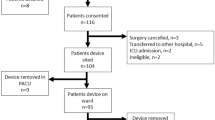Abstract
Objectives
To measure, with the use of suprasternal Dopler ultrasound, the hemodynamic changes in patients and volunteers during air ambulance repatriation.
Design
Unblinded prospective observational study.
Setting
Chartered air ambulances for the international repatriation of patients.
Patients and participants
Six medical crew members and seven patients transported back to hospitals in the UK.
Interventions
The measurement of non-invasive blood pressure, ECG, heart rate, oxygen saturation and hemodynamic variables with suprasternal Doppler.
Measurements and results
There was a drop in systolic and mean arterial blood pressure in the patient's group once in the air. Oxygen saturation dropped in both groups once at cruising altitude. Heart rate remained unchanged. Stroke distance and minute distance increased significantly in the patient's group and non-significantly in the volunteers. Peak velocity increased significantly in the patient's group. There was an overall reduction of systemic vascular resistance during take off and once at cruising altitude.
Conclusions
Hemodynamic changes happen during air ambulance transportation in fit and healthy volunteers and patients alike. These may be due to a combination of hypobaric hypoxia and gravitational forces. It is necessary to establish if these changes have short-or long-term effects in the critically ill.
Similar content being viewed by others
References
Gong H (1992) Air travel and oxygen therapy in cardiopulmonary patients. Chest 101: 1104–1113
Asmussen E, Consolazio F (1941) The circulation in rest and work on mount Evans (4,300 m). Am J Physiol 132:555–563
Hartley H (1971) Effects of high altitude environment on the cardiovascular system of man. JAMA 215: 241–244
Graham WGB, Houston CS (1978) Short-term adaptation to moderate altitude. JAMA 240:1491–1494
Berg BW, Dillard TA, Derderian SS et al. (1993) Hemodynamic effects of altitude exposure and oxygen administration in chronic obstructive pulmonary disease. Am J Med 94: 407–412
Pohl U, Busser R (1989) Hypoxia stimulates release of endothelium-derived relaxant factor. Am J Physiol 256: H1595-H1600
Michiels C, Arnould T, Dieu M et al. (1993) Stimulation of prostaglandin synthesis by human endothelial cells exposed to hypoxia. Am J Physiol 264: C866-C874
Vallet B, Winn MJ, Asante NK et al. (1994) Influence of oxygen on endothelium derived relaxing factor nitric oxide and K+ dependent regulation of vascular tone. J Cardiovasc Pharmacol 25: 592–602
Espersen K, Jensen EW, Rosenborg D, Thomsen JK, Eliasen K, Olsen NV, Kanstrup IL (1995) Comparison of cardiac output measurements techniques: thermodilution, Doppler, CO2-rebreathing and the direct Fick method. Acta Anaesthesiol Scand 39: 245–251
Gardin JM, Dabestani A, Martin K et al. (1984) Reproducibility of Doppler aortic flow measurements: studies of intraobserver, interobserver and day-today variability in normal studies. Am J Cardiol 54: 1092–1098
Author information
Authors and Affiliations
Corresponding author
Rights and permissions
About this article
Cite this article
Malagon, I., Grounds, R.M. & Bennett, E.D. Changes in cardiac output during air ambulance repatriation. Intensive Care Med 22, 1396–1399 (1996). https://doi.org/10.1007/BF01709557
Received:
Accepted:
Issue Date:
DOI: https://doi.org/10.1007/BF01709557




